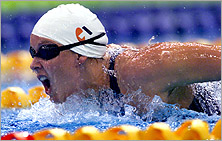

|
The Olympic flag has a plain white background with no border. In the centre are five rings forming two rows of three rings above and two below. The rings of the upper row are, from left to right, blue, black and red. The rings of the lower row are yellow and green. The rings are thought to symbolise the five continents: Europe, Asia, Africa, Australia and America. It is widely believed that the colours of the rings were chosen because at least one of them can be found in the flag of every nation, though this has never been confirmed as the intention of the designer. The flag was presented by Games founder Baron de Coubertin at the 1914 Olympic Congress, celebrating the 20th anniversary of the founding of the IOC. It was first flown in Alexandria, Greece, but made its Olympic debut at the 1920 Antwerp Games. This well-worn flag was finally retired after the 1984 Games, and a new one flown at the 1988 Seoul Games. At the Closing Ceremonies of the Olympic Games, the mayor of the current Olympic host city presents the flag to the mayor of the next host city. The flag is then kept in the town hall of the host city until the next Olympic Games. |
|
|
|
The Olympic flame is a symbol carried over from the ancient Olympics, where a sacred flame burned at the altar of Zeus throughout competition. It was finally reintroduced at the 1924 Amsterdam Games, and again burned in 1932. Carl Diem, chairman of the organising committee for the 1936 Berlin Games, proposed that the flame be lit in Greece and transported to Berlin via a torch relay. The idea was adopted, and continued at every Olympic Games since 1952. The flame is lit at the ancient site of Olympia by the natural rays of the sun reflected off a curved mirror. It is lit at a ceremony by women dressed in robes resembling those worn in ancient times, who then pass it to the first relay runner. |
|
|
"Citius, altius, fortius" is a Latin phrase meaning "swifter, higher, stronger", which Baron de Coubertin borrowed from Father Henri Martin Dideon of Paris. Dideon was headmaster of Arcueil College, and used the phrase to describe the athletic achievements of students at the school. He had previously been at the Albert Le Grand school, where the Latin words were carved in stone above the main entrance. |
|
"In the name of all competitors, I promise that we shall take part in these Olympic Games, respecting and abiding by the rules that govern them, in the true spirit of sportsmanship, for the glory of sport and the honour of our teams." Written by Baron de Coubertin, the oath is taken by an athlete from the host nation while holding a corner of the Olympic flag. The athletes' oath was first taken by Belgian fencer Victor Boin at the 1920 Antwerp Games. A judge from the host country also speaks the oath, with slightly different wording. |
|
"The most important thing in the Olympic
Games is not to win but to take part, just as the most
important thing in life is not the triumph, but the
struggle. The essential thing is not to have conquered, but
to have fought well." There have been many permutations of this
basic message throughout Games history, though this is the
current creed which appears on the scoreboard during the
Opening Ceremony. Baron de Cobertin adopted, and later
quoted, this creed after hearing the Bishop of Central
Pennsylvania, Ethelbert Talbot, speak at a service for
Olympic athletes during the 1908 London Games. In London for the Fifth Conference of
Anglican Bishops, Talbot's exact words at the service on
July 19, 1908 were: "The important thing in these Olympics
is not so much winning as taking part."

